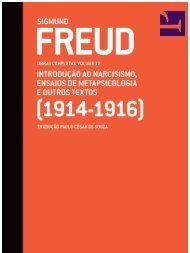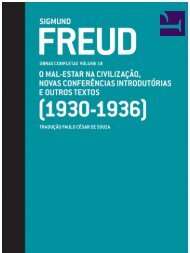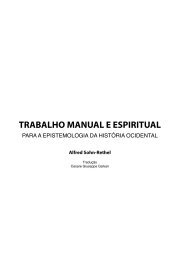Perversion the Social Relation
Perversion the Social Relation
Perversion the Social Relation
- No tags were found...
You also want an ePaper? Increase the reach of your titles
YUMPU automatically turns print PDFs into web optimized ePapers that Google loves.
Contamination's Germinations 203invigoration, connection, and change. But ra<strong>the</strong>r curiously Freud speaksof germ cells exhibiting narcissistic behavior in <strong>the</strong>ir conjugation: "Thegerm-cells <strong>the</strong>mselves would behave in a completely narcissistic fashion."28 Why put this behavior in terms of narcissism?If germs cells can be narcissistic, ra<strong>the</strong>r than seek to consider <strong>the</strong> prosopopoeicimplications of this, let us think ra<strong>the</strong>r of <strong>the</strong> complicationsfor individualism this raises, and <strong>the</strong> consequences for understandingnarcissism—and drive, particle, agency—from a nonindividualistic vantage.The formulation of narcissistic germ cells emphasizes <strong>the</strong> direction, or libidinal aim of <strong>the</strong> energetic investment; narcissistic libido is not directedat o<strong>the</strong>r objects, but is turned toward <strong>the</strong> self. Freud claims toderive <strong>the</strong> "narcissistic libido of <strong>the</strong> ego from <strong>the</strong> stores of libido bymeans of which <strong>the</strong> cells of <strong>the</strong> soma are attached to one ano<strong>the</strong>r." 25 Soit is striking that narcissism, which would seem to isolate a cell fromo<strong>the</strong>rs because its libidinal focus would be on itself, is bound up with adrive that foments connection, conjugation. Such terms are as remarkablycontradictory as Freud's torqued use of <strong>the</strong> non-synonyms "organicelasticity" and "inertia" in his formulation of <strong>the</strong> death drive. Wouldn'tnarcissism be more what one would expect from <strong>the</strong> death drive, a staticfocus on <strong>the</strong> self, a seeking to return to a prior state, to restore <strong>the</strong> lostwholeness of an earlier conception of self—not a reaching out to combinewith or connect to o<strong>the</strong>rs, seeking change?If White Noise presents a textbook case of <strong>the</strong> death drive, Accidentillustrates this interconnected view of <strong>the</strong> life drive, depicting it through<strong>the</strong> siblings. The connection between <strong>the</strong> narrator and her bro<strong>the</strong>r goesbeyond language. The link she projects early on, when she imagines himslipping away and chastises him for "going against <strong>the</strong> agreement," orher sudden burst into <strong>the</strong> "Ode to Joy" at 1145 P.M., which she later corroborateswith him: "I decided to ask you later, bro<strong>the</strong>r, just when youactually awoke from <strong>the</strong> anaes<strong>the</strong>tic that day which will have become <strong>the</strong>past. 1:45? you will say." 30 These moments of connection beyond languagerely on time for <strong>the</strong>ir corroboration, but though <strong>the</strong>y are harnessedwithin <strong>the</strong> confines of this rational paradigm, <strong>the</strong>y push us beyond <strong>the</strong>temporal principle. The uncanny coincidences, moreover, evoke a senseof mysterious and impossible connections, as if <strong>the</strong> siblings are indeedlinked through sharing <strong>the</strong> same germ-plasm. They reinscribe preciselythat convergence of <strong>the</strong> automaton that Copjec values in Lacan and Aris-








